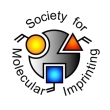Authors: Liu J, Li L, Tang H, Zhao FL, Ye BC, Li YC, Yao J
Article Title: Preparation and characterization of erythromycin molecularly imprinted polymers based on distillation-precipitation polymerization.
Publication date: 2015
Journal: Journal of Separation Science
Page numbers: n/a.
DOI: 10.1002/jssc.201500448
Abstract: Erythromycin-imprinted polymers with excellent recognition properties were prepared by an innovative strategy called distillation-precipitation polymerization. The interaction between erythromycin and methacrylic acid was studied by ultraviolet absorption spectroscopy, and the as-prepared materials were characterized by Fourier-transform infrared spectroscopy and scanning electron microscopy. Moreover, their binding performances were evaluated in detail by static, kinetic and selective sorption tests. It was found that the molecularly imprinted polymers afforded good morphology, monodispersity, and high adsorption capacity when the fraction of the monomers was 7 vol% in the whole reaction system, and the adsorption data for imprinted polymers correlated well with the Langmuir model. The maximum capacity of the imprinted and the non-imprinted polymers for adsorbing erythromycin is 44.03 and 19.95 mg/g, respectively. The kinetic studies revealed that the adsorption process fitted a pseudo-second-order kinetic model. Furthermore, the imprinted polymers display higher affinity towards erythromycin, compared with its analogue roxithromycin. This article is protected by copyright. All rights reserved
Author keywords: Distillation-precipitation polymerization, Equilibrium, Erythromycin, Molecularly imprinted polymer, kinetics



Join the Society for Molecular Imprinting

New items RSS feed
Sign-up for e-mail updates:
Choose between receiving an occasional newsletter or more frequent e-mail alerts.
Click here to go to the sign-up page.
Is your name elemental or peptidic? Enter your name and find out by clicking either of the buttons below!
Other products you may like:
 MIPdatabase
MIPdatabase









